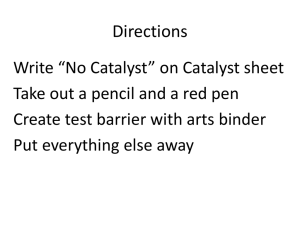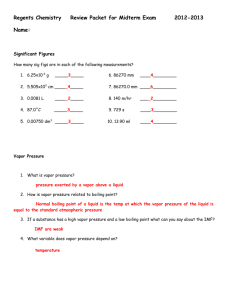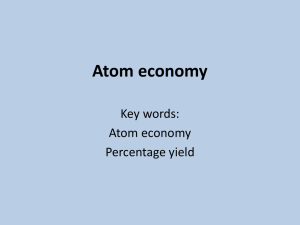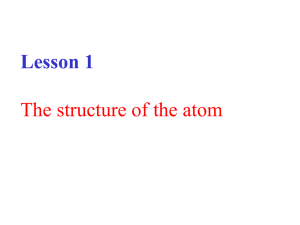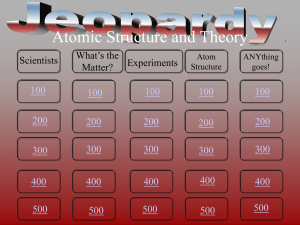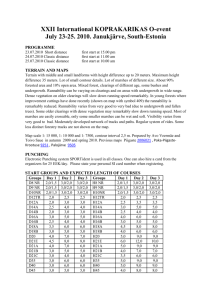Intro Nuclear Science v1 - radiochem
advertisement
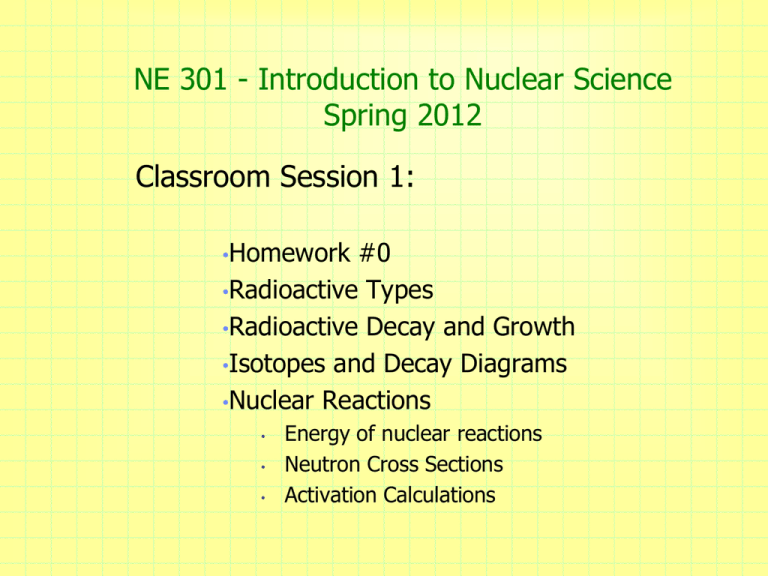
NE 301 - Introduction to Nuclear Science Spring 2012 Classroom Session 1: •Homework #0 •Radioactive Types •Radioactive Decay and Growth •Isotopes and Decay Diagrams •Nuclear Reactions • • • Energy of nuclear reactions Neutron Cross Sections Activation Calculations Solution to Homework #0 Please bring clickers to class. We will start next session to collect points. Please bring calculators. Get in pairs, feel free to talk across tables. Time on task please. I want everybody working to get answers. 2 1. What is atomic and molecular weight? What is the difference between the two concepts? Weight of an atom vs. weight of a molecule. Both can be given in: AMU or grams/mole 3 Example: What is the molecular mass of Uranil Sulfate (UO2SO4)? M(UO2SO4)= MU+6*MO+MS M(UO2SO4)= MU+6*MO+MS = = 238.029 g/mol + 6* 15.999 g/mol + 32.066 M(UO2SO4) = 366.089 g/mol or amu REMEMBER: If nothing else is said, masses are natural isotope mixtures. 4 2. Define the Avogadro’s number according to your own understanding. Think of a dozen, but 6.022e23 instead. What is the weight of a mol of H2 molecules? What is the weight of a mol of H atoms? What is the weight of a mol of electrons? 5 3. Explain the difference between mass density () and atom density (N) =m/V N = # atoms / V Why atomic density is important in nuclear engineering? Nuclear reactions are a collision Rxn. Rate = N 6 4. What is the atom density of oxygen in water? ( = 1 g/cm3, M = 18 g/mol). What is the atom density of hydrogen in water? # of H 2 O M olecules in 1 g = 1 g H 2 O 6.02e23 m olecules H 2 O 3.34 e 22 18 g Density of oxygen atoms: Density of hydrogen atoms: What is the density of water molecules in water? 7 5. Cylinder with a diameter and height of 10 cm weights 15.16 kg. What is it likely made out of? 10 cm 10 cm Google it! 8 6. What is the classical formula for kinetic energy? How much kinetic energy has a baseball traveling at 100mph in Joules? How much would it cost to buy that amount of electrical energy (assume 10¢/kW-h) Google mass of baseball = 5oz Quad-Lock Unit Converter (or some such) J W.s =0.0004 ¢ 9 7. How much energy in Joules is there in a proton if we could convert it entirely in energy using Einstein equation (E=mc2)? How much is that in KW-h? Either kg mc2 J kW-h Or MeV J kW-h How many protons Callaway convert by fission a day (3,700 MW of installed capacity)? 10 8. The average mass of potassium in the human body is ~140g. What is the activity (Bq) of 40K in the body? A=N. T1/2=1.27e9 y The natural abundance of 40K is: 0.0117 %, so N for 40K N ( nat . K ) 140 g 1 m ole 6.02 e 23 atom s 39.0983 g 2.16 e 24 atom s 1 m ole N ( 40 K ) 2.16 atom s 0.000117 2.52 e 20 atom s of A( 40 K ) N . 2.52 e 20 Ln 2 1.27 e 9 y 1y 365 d 1d 24 h 40 1h K 4361.3 Bq 3600 s 11 9.The activity of a radioisotope is found to decrease by 35% in one week. What are the values of its: A A e (a) decay constant (days-1) 0.7 A A e .t 0 .1 w eek 0 0 Ln 0.7 = . 1 w eek -0.357 =- 0.357 w eek -1 1 w eek (b) half life (days) Ln 2 T1 / 2 0.693 T1 / 2 (c) mean life(days)? t t 0.357 w eek -1 1.943 w eeks 1 1 0.357 w eek -1 2.804 w eeks 12 11. How many atoms are there in a 1.00 MBq source of Na T =15.020 h (a) 24Na (b) 238U 24 1/2 A N N A 1.00 e 6 B q ln 2 15.020 h 7.80 e10 atom s 1 h 3600 s M ( 24 N a ) 23.990963 g/m ol 1 m ol m 7.8 e10 atom s 23.900963 g 6.02 e 23 atom s 3.10 e 12 g 1 m ol = 3.10 pg 238U T1/2=4.468x109 y A N N A 1.0 e 6 B q ln 2 4.468 e 9 y 1 y 365 d 2.03 e 23 atom s 1 d 24 h 1h 3600 s M ( 24 N a ) 238.050783 g/m ol m 2.03 e 23 atom s 1 m ol 6.02 e 23 atom s 238.050783 g 80.38 g 1 m ol Notice that equally active sources can have vastly different masses (14 orders of magnitude) depending on half-life. Short-lived isotopes are a lot more active than long-lived ones. 13 Nuclear Science 14 Atomic and Nuclear Nomenclature A Z X X element symbol (H, He, Na, Xe, U, etc.) represents the number of charges in the nucleus (thus electrons, thus chemical behavior). A = Mass number = protons + neutrons = Nucleons. Z = atomic number = protons. X and Z are redundant and normally we only write AX. e.g. 235U, 16O, 3H, 14C 15 Chart of the Nuclides Isobars Isotopes Z Isotones N 16 17 Isobars = A 18



